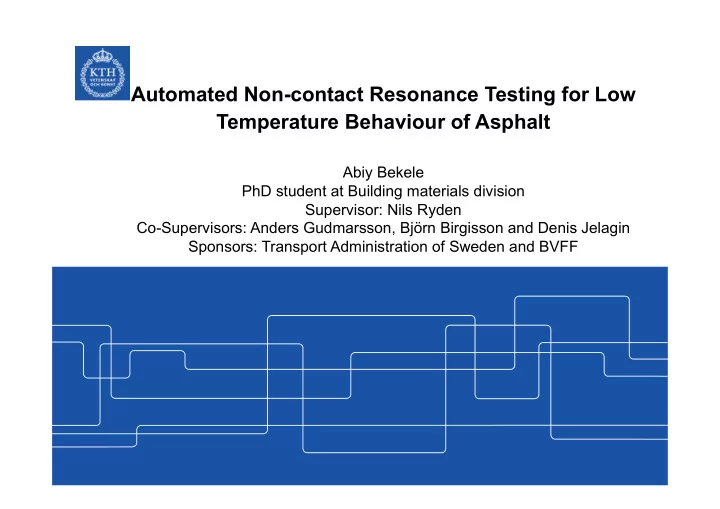

Automated Non-contact Resonance Testing for Low Temperature Behaviour of Asphalt Abiy Bekele PhD student at Building materials division Supervisor: Nils Ryden Co-Supervisors: Anders Gudmarsson, Björn Birgisson and Denis Jelagin Sponsors: Transport Administration of Sweden and BVFF
Resonance Testing on Asphalt q Stress waves can be imposed into a material through impacting q Different modes of vibration depending on the application of the excitation 1000 ] Acceleration [m/s × 500 0 q Time domain sinosoidal signals -500 -1000 converted to frequency domain 0 1 2 3 4 5 6 Time [s] -3 x 10 300 Acceleration [m/s × ] q RAS used for determining elastic 200 and visco-elastic properties 100 0 0 0.5 1 1.5 2 Frequency [Hz] 4 x 10 2
Research Questions q Impacting for Resonance testing is carried out manually Automating the testing procedure q Asphalt is highly susceptible to temperature An improved control of measurement temperatures required q The long term sole effects of low temperature conditioning on asphalt is yet to be fully understood q Cyclic low temperature effects on asphalt 3
Non-Contact Acoustic excitation q Resonance induced by means of air- coupled acoustics q Irradiating sound waves within acoustic frequency range q Useful in modal experiments that require small measureable strains Adopted from Kageyoshi Katakura 1 , Ryo Akamatsu 2 , Tsuneyoshi Sugimoto 2 and Noriyuki Utagawa 4
Experimental Protocol: Non-Contact method q Automated Non-contact method of resonance application Loud 0.015 Speaker Response after 0.01 excitation 0.005 Volts 0 Accelero -0.005 Specimen meter -0.01 -0.015 0 2 4 6 8 10 Time [Sec] Signal Mode of vibration Processing 12 10 Acceleration [m/s 2 ] Foam for boundry 8 conditions 6 4 2 0 Data Aquisition 0.8 0.85 0.9 0.95 1 1.05 1.1 1.15 1.2 Frequency [Hz] 4 x 10 5
Measuremement at Low temperatures q Measurement on sample ABT-11 q RF increases with temperature decrease q Amplitude increases as temperature decreases RF damped Quality factor 200 25 At 0 180 At -10 ° C At -20 ° C 20 160 At -30 ° C At -40 ° C 140 Quality ¡F actor 2 ] Acceleration [m/s 15 120 100 10 80 60 5 40 20 0 -50 -40 -30 -20 -10 0 10 0.8 0.85 0.9 0.95 1 1.05 1.1 1.15 1.2 Frequency [Hz] 4 T emperature ¡( ¡ ° ¡C ) x 10 6
Example of Results q General increase of dynamic modulus with decrease in temperature q Behaviour of visco-elasticity can be monitored q Possibility to compare different mixtures 4 10 x 10 x 10 1.08 3.8 ABT 11 ABT 11 1.06 ABS 11 ABS 11 3.6 Resonance Frequency(Hz) Dynamic Modulus(Pa) 1.04 3.4 1.02 3.2 1 3 0.98 2.8 0.96 2.6 -50 -45 -40 -35 -30 -25 -20 -15 -10 -5 0 5 10 -50 -45 -40 -35 -30 -25 -20 -15 -10 -5 0 5 10 Temperature ( ° C) Temperature ( ° C) 7
Remarks q The proposed method showed good repeatability and reproducibility q An automated technique q Good aggreement with contact Resonance measurement q Non-contact method of measurement has the following advantages § Avoids variation of measurement results § Temperature can be kept constant during measurement § Efficient in studying low temperature behaviours of asphalt § Measurement procedure is relatively simpler 8
Thank You! 9
Recommend
More recommend